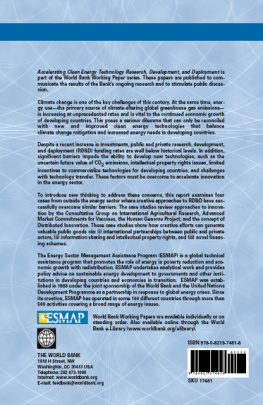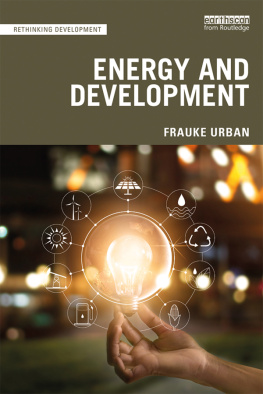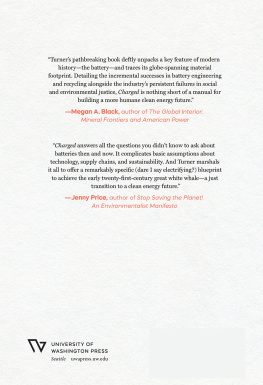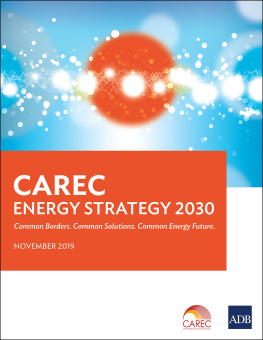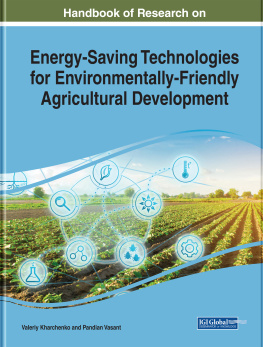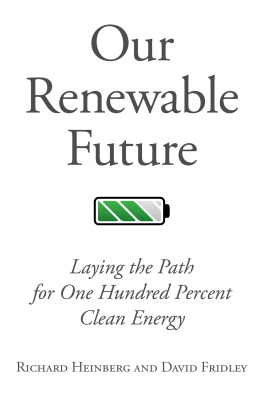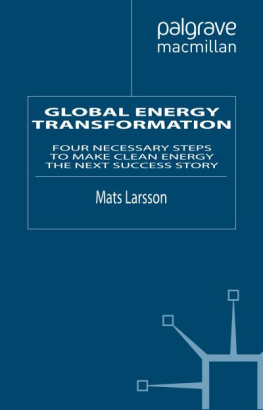WORLD BANK WORKING PAPER NO . 138
Copyright
Copyright 2008
The International Bank for Reconstruction and Development / The World Bank 1818 H Street, N.W.
Washington, D.C. 20433, U.S.A.
All rights reserved
Manufactured in the United States of America
First Printing: May 2008

1 2 3 4 5 11 10 09 08
World Bank Working Papers are published to communicate the results of the Bank's work to the development community with the least possible delay. The manuscript of this paper therefore has not been prepared in accordance with the procedures appropriate to formally-edited texts. Some sources cited in this paper may be informal documents that are not readily available.
The findings, interpretations, and conclusions expressed herein are those of the author(s) and do not necessarily reflect the views of the International Bank for Reconstruction and Development/
The World Bank and its affiliated organizations, or those of the Executive Directors of The World Bank or the governments they represent.
The World Bank does not guarantee the accuracy of the data included in this work. The boundaries, colors, denominations, and other information shown on any map in this work do not imply any judgment on the part of The World Bank of the legal status of any territory or the endorsement or acceptance of such boundaries.
The material in this publication is copyrighted. Copying and/or transmitting portions or all of this work without permission may be a violation of applicable law. The International Bank for Reconstruction and Development/The World Bank encourages dissemination of its work and will normally grant permission promptly to reproduce portions of the work.
For permission to photocopy or reprint any part of this work, please send a request with complete information to the Copyright Clearance Center, Inc., 222 Rosewood Drive, Danvers, MA 01923, USA, Tel: 978-750-8400, Fax: 978-750-4470, www.copyright.com.
All other queries on rights and licenses, including subsidiary rights, should be addressed to the Office of the Publisher, The World Bank, 1818 H Street NW, Washington, DC 20433, USA, Fax: 202-522-2422, email: .
ISBN-13: 978-0-8213-7481-8
eISBN: 978-0-8213-7481-8
ISSN: 1726-5878 DOI: 10.1596/978-0-8213-7481-8
Cover Photos: Bottom right: CFE's (Comisin Federal de Electricidad) La Venta II Wind Farm in Oaxaca, Mexico. Courtesy of Daniel Farchy, www.farchy.com. Remaining photos are the courtesy of the World Bank Group Photo Library.
Library of Congress Cataloging-in-Publication Data
Avato, Patrick, 1979
Accelerating clean energy technology research, development, and deployment : lessons from non-energy sectors / Patrick Avato, Jonathan Coony.
p. cm.(World Bank working paper ; No. 138)
Includes bibliographical references.
ISBN 978-0-8213-7481-8ISBN 978-0-8213-7481-8 (electronic)
1. Renewable energy sources. I. Coony, Jonathan. II. Title.
TJ808.V83 2008
333.79'15dc22
2008013192
Contents
Contents
| Foreword |
| Acknowledgments |
| Acronyms and Abbreviations |
| Executive Summary |
| 1. | Introduction |
| 2. | Climate Change and the Need for New Clean Energy Technologies |
| The Growing Global Concern about the Threat of Climate Change |
| Clean Energy Technology Options |
| The Need for New and Improved Clean Energy Technologies |
| 3. | Trends in Energy Research and Development Spending |
| A Period of Reduced Energy R&D Spending from Mid-1980s to Early 2000s |
| Renewed Public and Private RD&D Activity in Recent Years |
| The Increasing Role of Rapidly Growing Client Countries in Energy RD&D |
| The Limits of Renewed Energy RD&D Activity |
| 4. | Barriers to the Development and Deployment of Clean Energy Technologies |
| Negative Externality of Carbon Emissions Is Difficult to Valuate |
| Climate Change Mitigation Is a Global Public Good |
| The Valley of Death between Public- and Private-Sector Development |
| The Mountain of Death of Technology Costs |
| Technology Needs of Developing Countries Are Not Adequately Served |
| Intellectual Property Right Protection is a Concern |
| The Network Structure of the Electricity Sector Limits Integration of New Technology |
| National Interests Can Impede International Collaboration |
| Energy RD&D Can Require Large, Sunk Capital Investments |
| The Commodity Nature of Electricity |
| Carbon Lock-in, Subsidies, and Barriers to Trade |
| Imperfect and Asymmetric Information |
| 5. | Case Studies of Technical Innovation from Other Sectors |
| Agriculture and the Consultative Group on International Agricultural Research (CGIAR) |
| Vaccines and Advanced Market Commitments (AMCs) |
| Biotechnology and the Human Genome Project (HGP) |
| Open Source Software, Creation Networks, and Distributed Innovation |
| 6. | Lessons Learned |
| Bridging the Valley of Death |
| Pooling Resources to Address Global Public Goods |
| Facilitating Innovative Research Partnerships |
| Transferring Technology: South-South and North-South |
| Sharing Information and Addressing Intellectual Property Rights |
| Setting Goals without Picking Winners |
| Using World Bank Group Strengths to Promote Technology Development |
| 7. | Going Forward |
| Appendixes |
| A | The Stages of Energy Technology Innovation |
| B | Overview of Selected Clean Energy Technology Options |
| C | Analyses Supporting the Need for Technological Innovation |
| D | Historical Data on Government Energy R&D Spending |
| Bibliography |
| List of Tables |
| 1. | Summary of Case Studies of Technology Innovation in Non-energy Sectors |
| 2. | Agricultural R&D Spending and the Role of the CGIAR |
| 3. | AMC Donors Commitments for a Pneumococcal Vaccine |
| 4. | Human Genome Project Funding (US$ millions) |
| 5. | Innovative RD&D Approaches to Address Barriers to Technology Development |
| A2.1 | Clean Energy Technologies and Mitigation Potential Resulting from Accelerated Technology Innovation |
| A4.1 | Public R&D Expenditures in IEA Countries |
| A4.2 | Combined Spending by All IEA Governments on Energy R&D (million of US$ in 2004 prices and exchange rates) |
| List of Figures |

